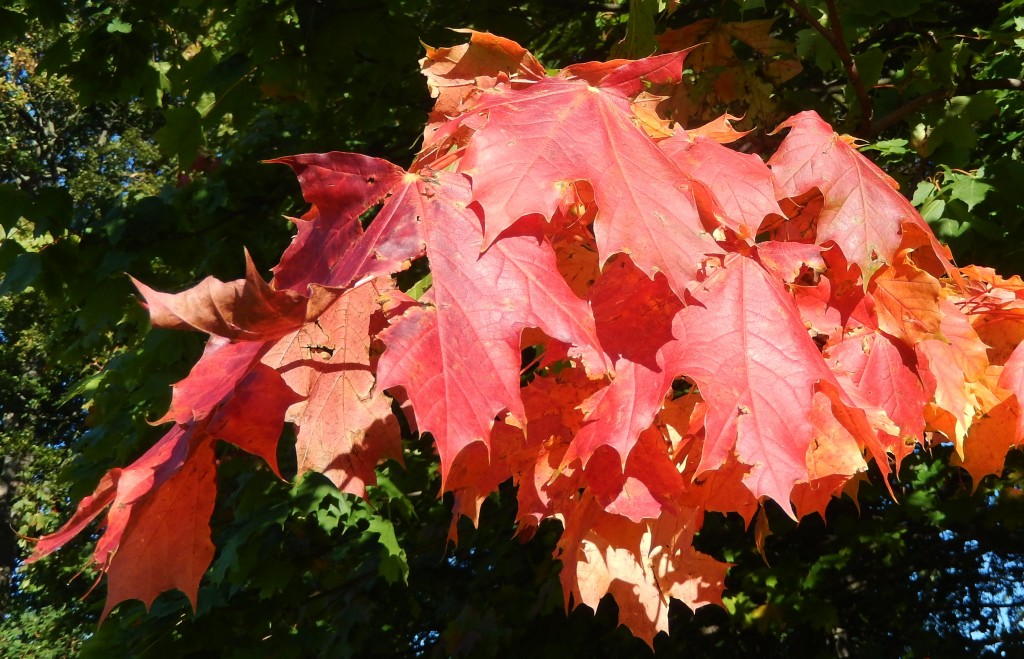

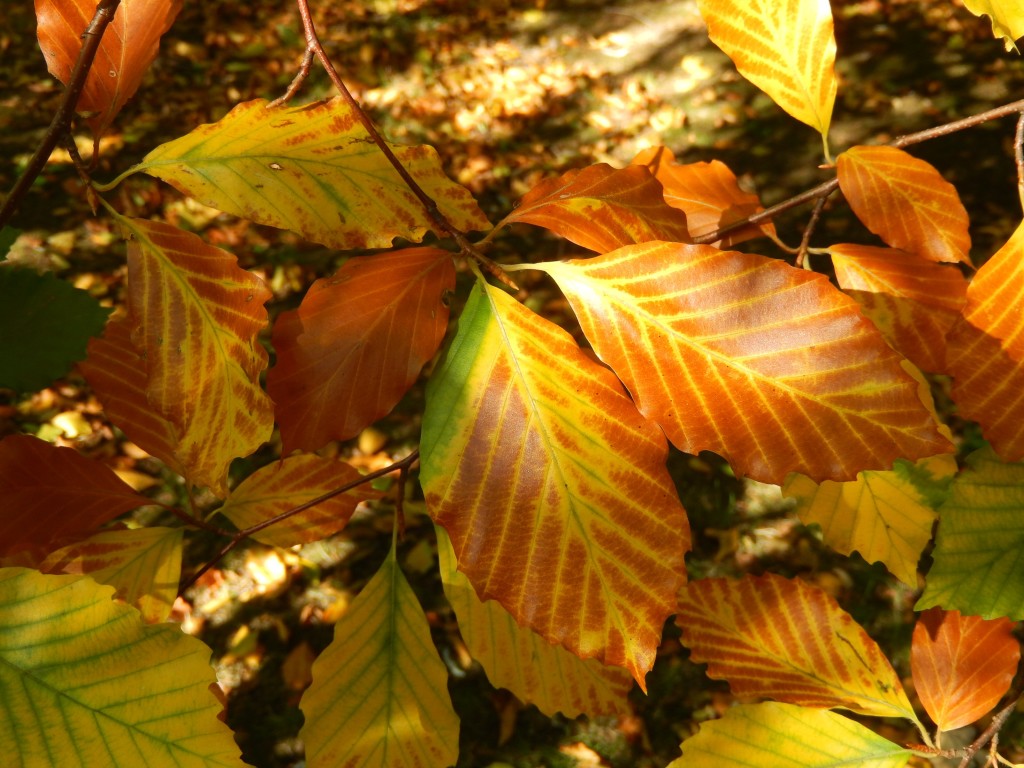
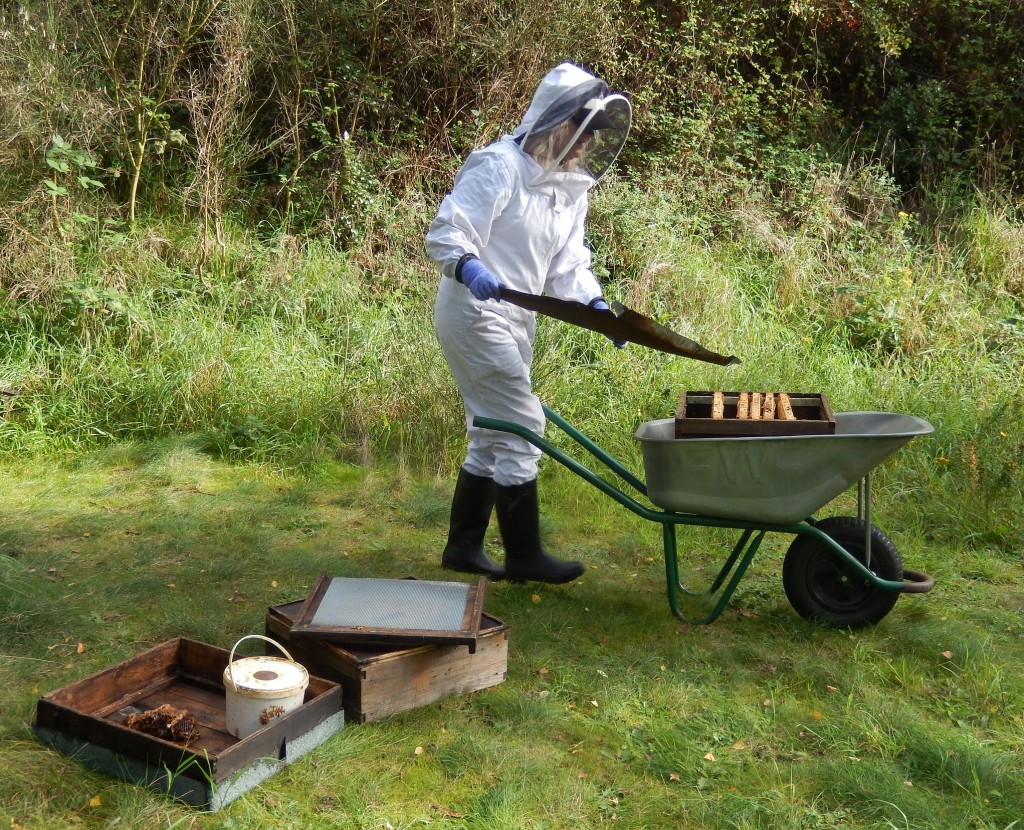
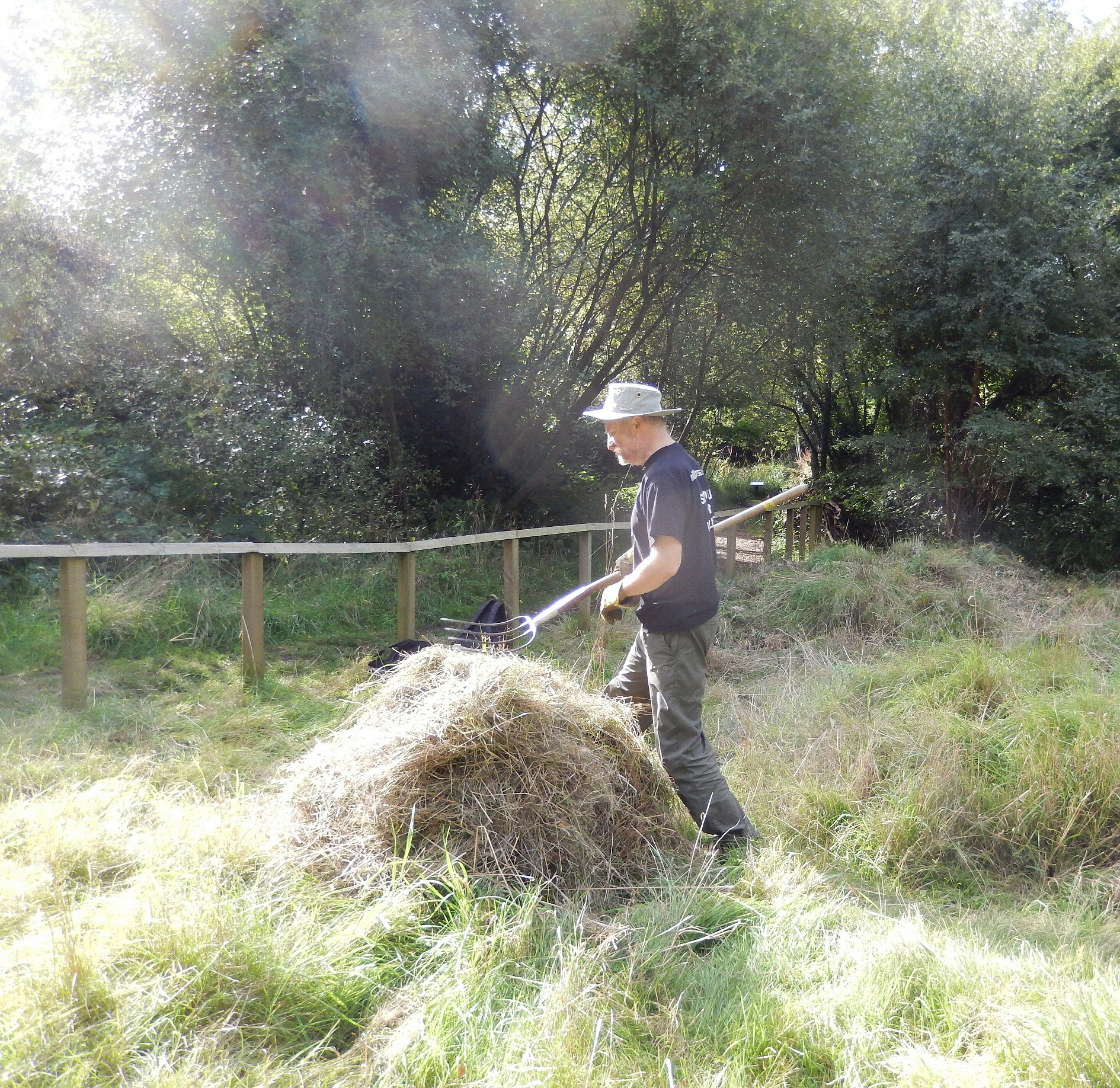
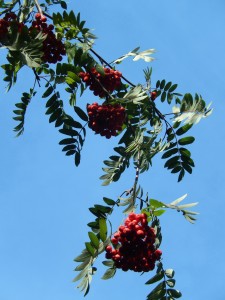
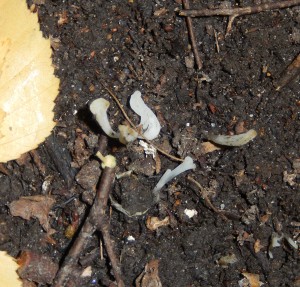
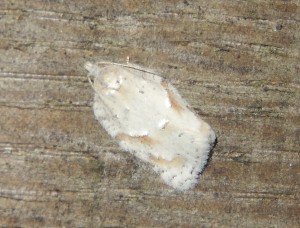


The skies over London were beautifully clear for tonight’s astronomical event. A total lunar eclipse, not exactly a rare event but uncommon enough, coincided rather well with perigee, the Moon’s closest approach to Earth.
A family member with good Greek observed that “peri” means “around” rather than close, making perigee an odd opposite for apogee, but there it is.
In the evening before the eclipse, the full Moon appeared as an exceptionally large, exceptionally bright disk. The rather ridiculous term ‘Supermoon‘ seemed not entirely inappropriate.
A little after 3 am, the moon slipped from the Earth’s penumbra into its umbra and, its disk some 10% larger than usual, appeared to be big and a handsome coppery-orange, in other words distinctly red. The image is in its unadjusted colours, and the camera was as still as I could wedge it, which for a long exposure isn’t saying much, but it gives the feeling of looking for oneself in the middle of the night.
Very gradually the area of brighter yellow-orange at lower left diminished. The Moon’s disk became less and less bright, slowly losing colour. Then equally gradually, an area of brighter yellow-orange started to grow at upper left.

Yesterday I went along to Kew Gardens’ new book festival to hear George Monbiot, the author of Feral: Rewilding the land, sea and human life (Penguin, 2014). He was genuinely inspirational.
We sat down in neat rows on elegantly stiff, lightly-made wooden chairs in the beautiful Nash Conservatory, the sun streaming right into our eyes; Monbiot’s first words were to apologise humorously for the rather bright lighting. The two large computer screens displayed the festival’s welcome screen, and stayed that way: Monbiot spoke without slides, and without notes. He was clear, sharp, warm, and where appropriate really quite entertainingly rude about government policy.
He told us how his excitement at moving to the Cambrian Mountains turned to puzzlement and then despair as he realized there were no trees: no birds: no butterflies: no bees: no flowers except Tormentil, indicator of poor soil. He directly and simply told us complicated stuff, like the Structural Heterogeneity of the rainforest, a whole architecture of ecosystems with multiple niches for species of every description. He reminded us that Britain has less tree cover than almost anywhere else in Europe – 12% against an average of 37%. His mountains had been shagged to death by sheep, ruined by the white plague; other mountains (Scotland, say) had been just as well trashed by management for shooting grouse or red deer. Britain had the second biggest landholdings of any country – after Brazil. Why? Because farm subsidies reward the largest landholders, the oil sheikhs and Russian oligarchs, the world’s luckiest landlords, paid for doing nothing but keeping the land in “agricultural condition”. And that meant? Keeping it free of what the bureaucrats call “permanent ineligible features”, in other words, trees. Britain’s mountains are wet deserts, profitable only to the rich. And they are paid to keep the land species-poor.
Even the nature reserves have “key indicator species” (Monbiot was really warming to his theme now, putting the boot in) like Red Grouse, Ring Ouzel, Skylark, Meadow Pipit: the few birds that thrive in bare open moorland (and there were hardly any of them, he said). Montgomeryshire’s claimed “really wild” jewel in the crown reserve was “identical” to the rest of the cold wet desert. It, like the rest of it, was maintained by a programme of cutting, burning and grazing to prevent trees and bushes from taking over. The “undesirable species”? They were, erm, native trees like Hawthorn and Birch, the pioneering colonisers that pave the way for all the trees of the forest, all the way up to, um, the beautiful natural primary forest of the Wildwood, complete with glorious epiphytic ferns like Polypody, great trailing beards of lichen, all the mosses and liverworts and flowers and invertebrates and beasts of every size that you’d find in a rainforest. It’s a circular argument: you need grazing to maintain “favourable condition”; and that is measured by indicator species which are the ones found on bare moorland; which you’ve defined as what favourable condition is. Only, that isn’t what the Eurocrats actually asked for: they specified “favourable ecological situation”, which might mean … wildwood. Quite the opposite.
Now for the sting: if the ranchers of Brazil start a program of cutting, burning and grazing to destroy the rainforest, leaving bare meadows for their cattle, there’s an international outcry. But in Britain, it’s the required management regime for our best nature reserves! We’re protecting the ranchers from the rainforest. Why is mid-Wales bare and open? Because for 200 years it was devastated by lead mining; and after that, grazed to nothing by sheep. The white death only need to be present at one sheep per ten Hectares (hardly any, basically) to kill all the new tree seedlings: young saplings are delicious and nutritious, and sheep greedily and selectively seek them out.
Well, I’m not going to try to recap the whole talk, let alone the whole book, which I’ve already reviewed for you. Rewilding, Monbiot says with simple and direct plausibility, is informed by Remembering. And our memories are terribly short. Back in the 18th Century, Oliver Goldsmith described the massive shoals of Herring in our waters; harried by enormous numbers of Tuna, Porbeagle, Sperm Whale, Fin Whale. Yes, there was in the past few centuries, recorded by careful scholarly intellectuals, a thriving Tuna fishery at Scarborough. Not the Tonnara in Sicily, now defunct; not the Tuna fishery of Monterey Bay with its Cannery Row, now a marvellous Aquarium (I have the T-shirt to prove it); but right here. Like our coast-to-coast temperate rainforest, it’s practically all gone.
BUT… we can have it back! “Amazing things can happen”, said Monbiot. There are Trophic Cascades, life pouring down from the top in an ecosystem. How? The classic example is from America’s Yellowstone National Park. The wolves were removed in the 1920s to “improve” on nature, allowing more deer (and better hunting). Only, it didn’t work out like that. The park, deprived of the wolf, became steadily poorer in wildlife. Then in 1995, after lengthy argument (very lengthy argument, in fact), the wolf was brought back in small numbers.
The effect was dramatic. Within six years, the trees were FIVE TIMES taller. The wolves had scattered the deer from their grazing haunts down by the rivers. Saplings sprouted. Trees shot up. Beavers felled trees to make dams and lakes. Waterside plants flourished. Fish, invertebrates, amphibians, reptiles and muskrats appeared all over. The wolves killed coyotes. Small animals appeared all over. The trees stabilised the banks of the rivers. The rivers meandered less; erosion patterns altered. Bison multiplied among the larger trees. Fruiting shrubs blossomed and bore berries; bears ate quantities of them, and fish. The wolves changed the landforms, planted trees, made flowers bloom. Everyone, including professional ecologists, was astonished.
What could we have here? Getting the moose, bison, bear and wolf back may take some time here in tightly-buttoned Britain. Elsewhere in Europe, wolverines are coming back from the far north; millions of beavers are making dams in dozens of countries; lynx are being reintroduced with minimal fuss. Everyone except us thinks it’s NORMAL. Everyone except the British governing elite (and their landowning friends and relatives) wants to see beavers and wild boar in our countryside: lynx, too.
Can we have wildlife and people? Sure.
Can we have wildlife and subsidies for grouse moors and a “stupid” Common Agricultural Policy? No. Even the supposedly “green” part of the CAP is insane – we pay 55 billion to farmers to do nothing with the land (except destroying trees), then we pay them a bit more to put a tiny bit of wildlife back on a tiny part of it: and even that part is basically worse than useless.
Conservation sites have to be resilient, argues Monbiot, self-willed, running nature’s own processes, if they are to survive the shocks that are coming. All we have to do is to let nature get on with it.
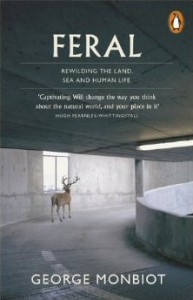
At the end we all trooped to a table where Monbiot signed our copies of Feral (here’s my book review), in my case a clean but pretty well-thumbed copy. He wrote “To Ian, with hope, George Monbiot”, and I went home in the sunshine thinking, yes, with hope: “conservation” sounds worthy and dull, like aunties with conservatories in their garden, or conservative opinions, or carefully conserving dusty artefacts against moth and museum beetle. But hope: hope that Britain will gain new and better kinds of nature reserve, full of deer, and beaver, and wild boar, and lynx, a sparkle of excitement at glimpsing what the wildwood was really like.
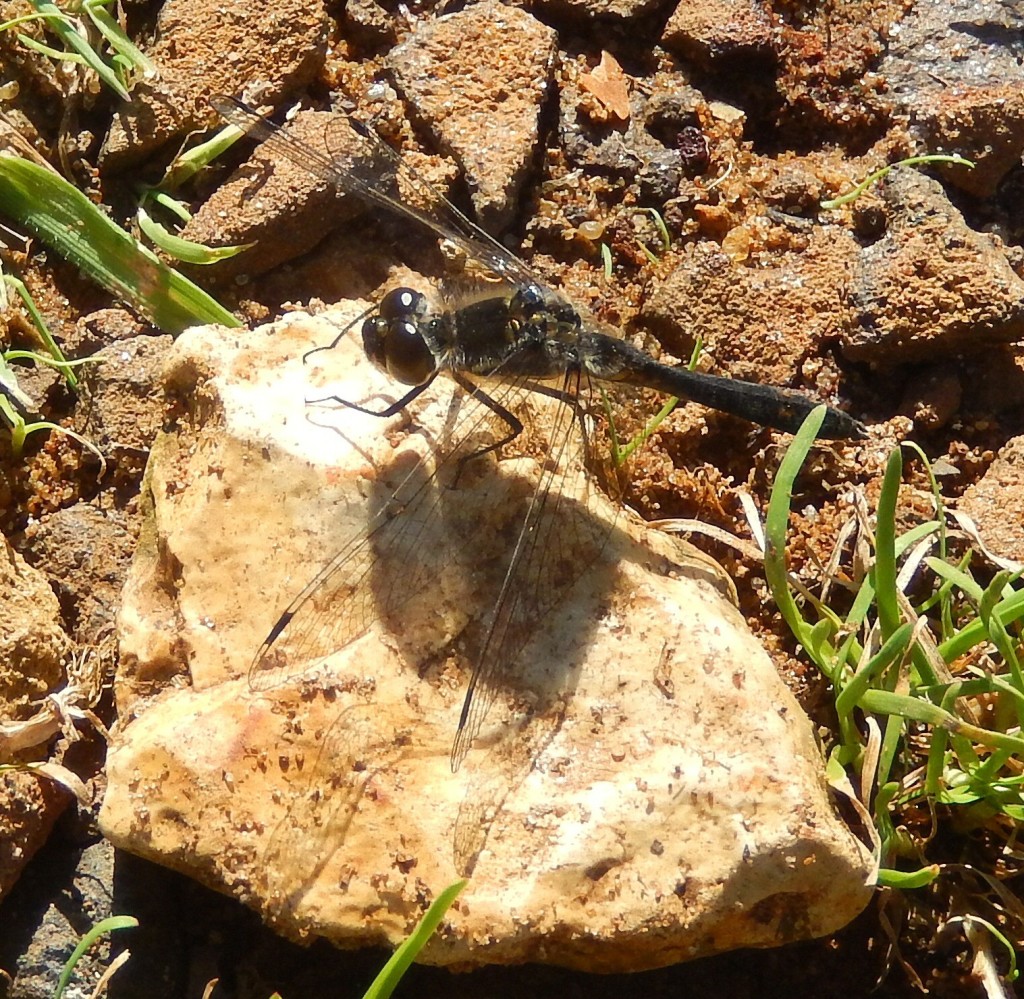
A flock of some fifty Swallows twittered high above the sparkling blue lake among the bog pools. Dragonflies – the occasional Emperor, plenty of small red Common Darters and tiny Black Darters, some Migrant Hawkers – dashed about or sunned themselves on the boardwalks. A pair of Hobbies, those dashing, Swift-winged falcons, soared and watched the Swallows cunningly, waiting for a careless moment. One of the Hobbies swooped down, raced low, agile, among the reeds, up and switchback over a dead tree to snatch a dragonfly on the wing, powered right across the wide bog all the way to the pinewoods. Three pairs of Common Darters in cop, the males leading the females, their claspers about their females’ necks, flew in strict formation like so many Spitfires. A Hobby, high above the bog, accelerated in a long straight shallow dive, for all the world like a Junkers 88 bomber taking careful aim, racing down for a hundred yards at incredible speed to grab a dragonfly: it must have seen its prey all that distance away.
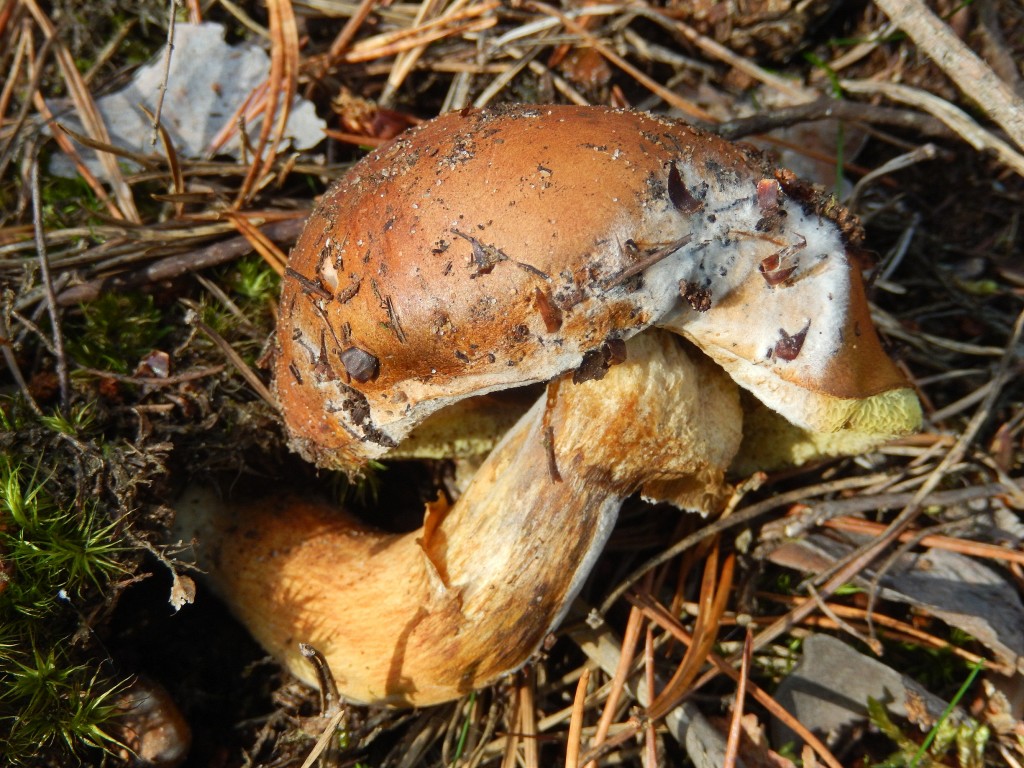
Clusters of the light brown Birch Bog Bolete – yes, it grows under Birches in Sphagnum bogs – are dotted about, their large squarish pores quite unlike the little round holes of the true Cep. Phillips says they’re edible but not worthwhile. This isn’t stopping a pair of plump thirty-something Poles with a sports bag wandering along collecting them (National Nature Reserve? Really?). I greet them, establish their nationality, say my mother used to do the same in the Carpathians and that there aren’t many mushrooms here. The guy with the sports bag shows me a meagre haul of Birch Bog Boletes just about lining the bottom of his bag: he means, he hasn’t found much worth collecting. I try Natsional Natur Reservat and waggle my finger, we part smiling and he shuffles off sheepishly.
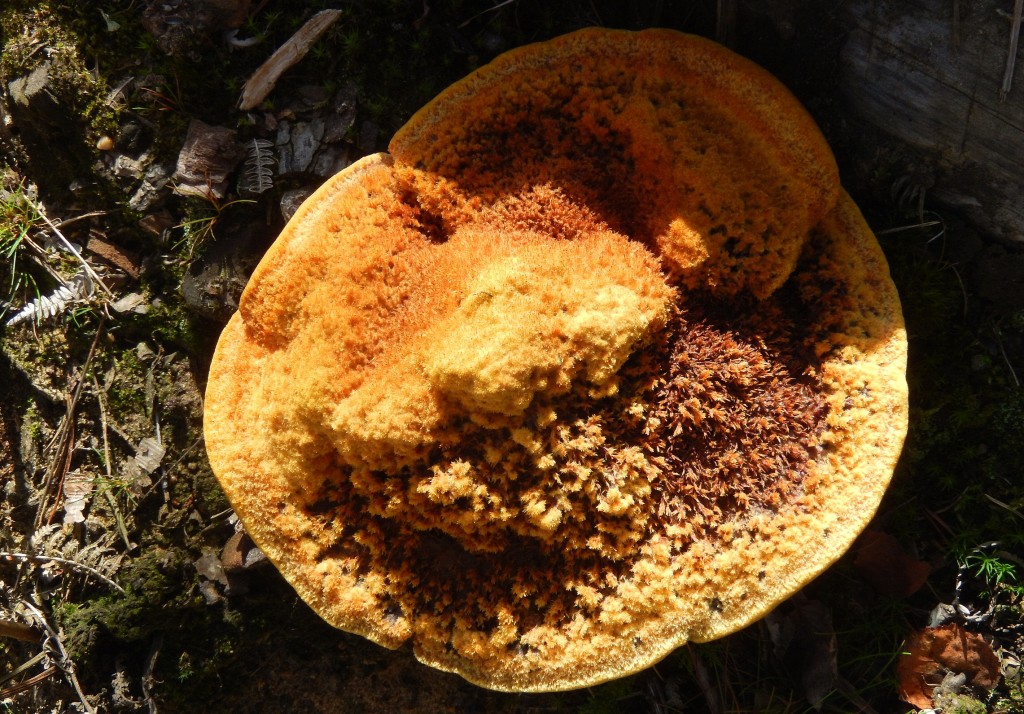
Under some Pine trees, a dead stump, killed by Phaeolus schweinitzii, three or four enormous dinner-plate sized yellow discs, thick and rough with orangey-brown branching tufts: they are overgrown Polypore bracket fungi, dangerous parasites of conifer tree roots. Nobody has given it an English name, which is a pity as the namers could really have fun with it: Yellow Pine Death? Giant Pine Polypore? A magnificent fungus, somewhat alarming if you’re a forester.
On the open sandy heath, some Ammophila sandwasps are still active, perching on the path. A few butterflies – a white, some Speckled Woods, probably a Red Admiral – are about; a very large brown butterfly with agile flight, dancing around a pine trunk and up high, is tantalisingly impossible to get binoculars on, was very probably a Fritillary, in which case it was likely the Silver-Washed Fritillary.
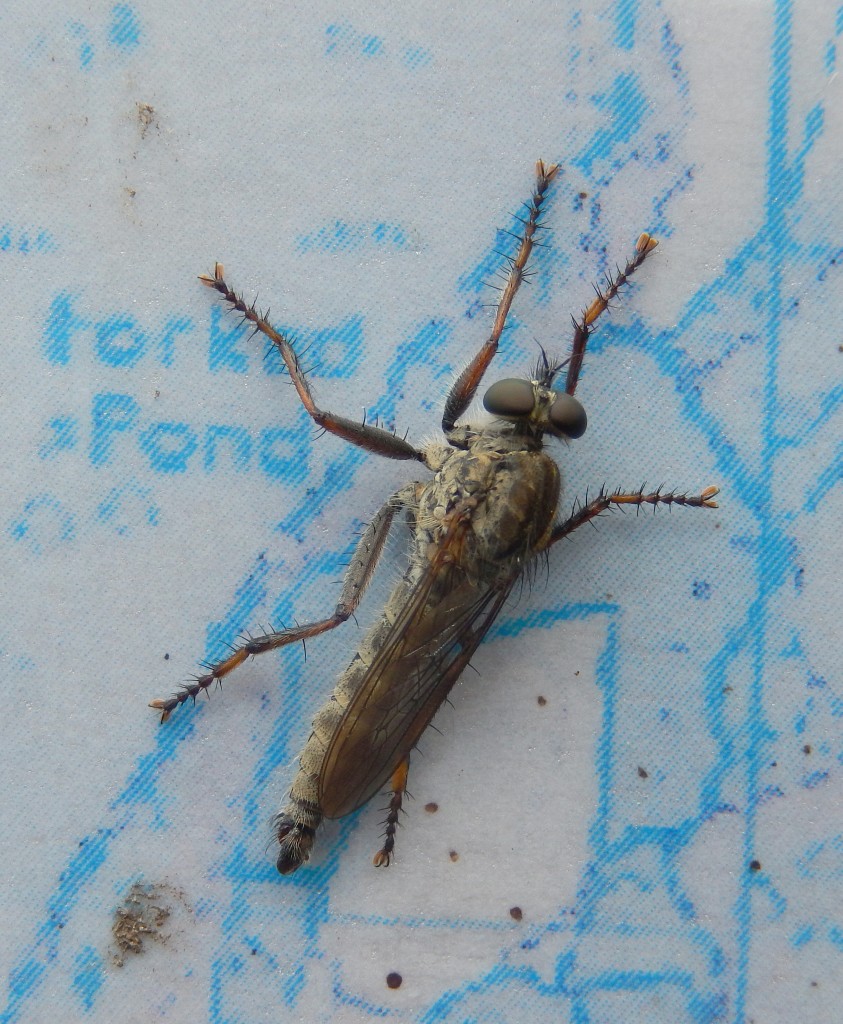
A couple of mean Robber Flies perched on a rather bleached map of the common: they had as Shakespeare said “a lean and hungry look”. They have a tuft of stiff bristles below their antennae to keep their prey from striking them in the head. They wait on a perch – a signboard will do if there’s nothing better – until an unsuspecting fly comes past, then they sally into the air and grab it.
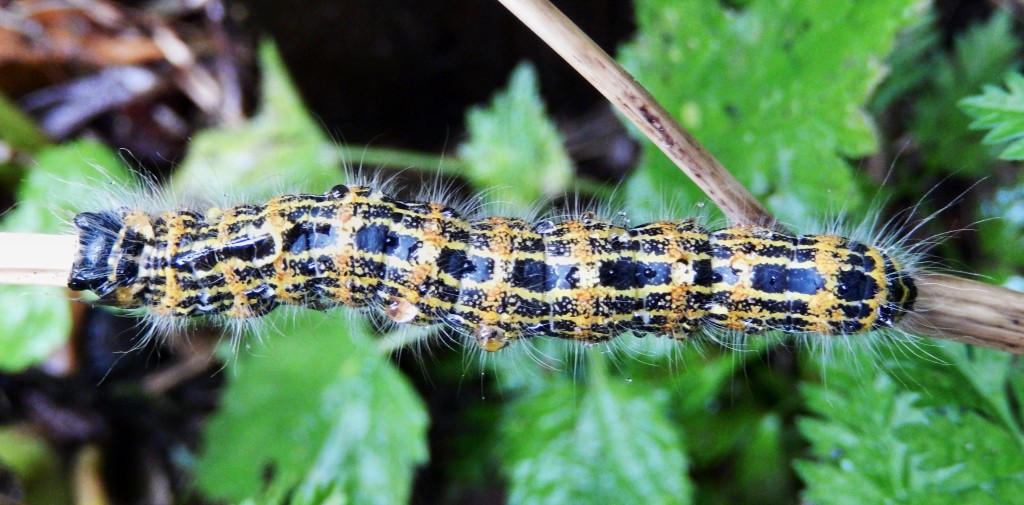
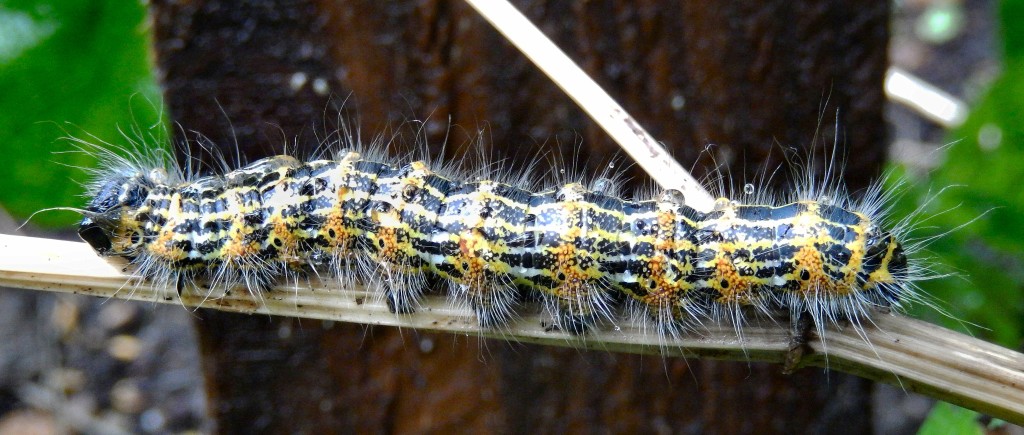
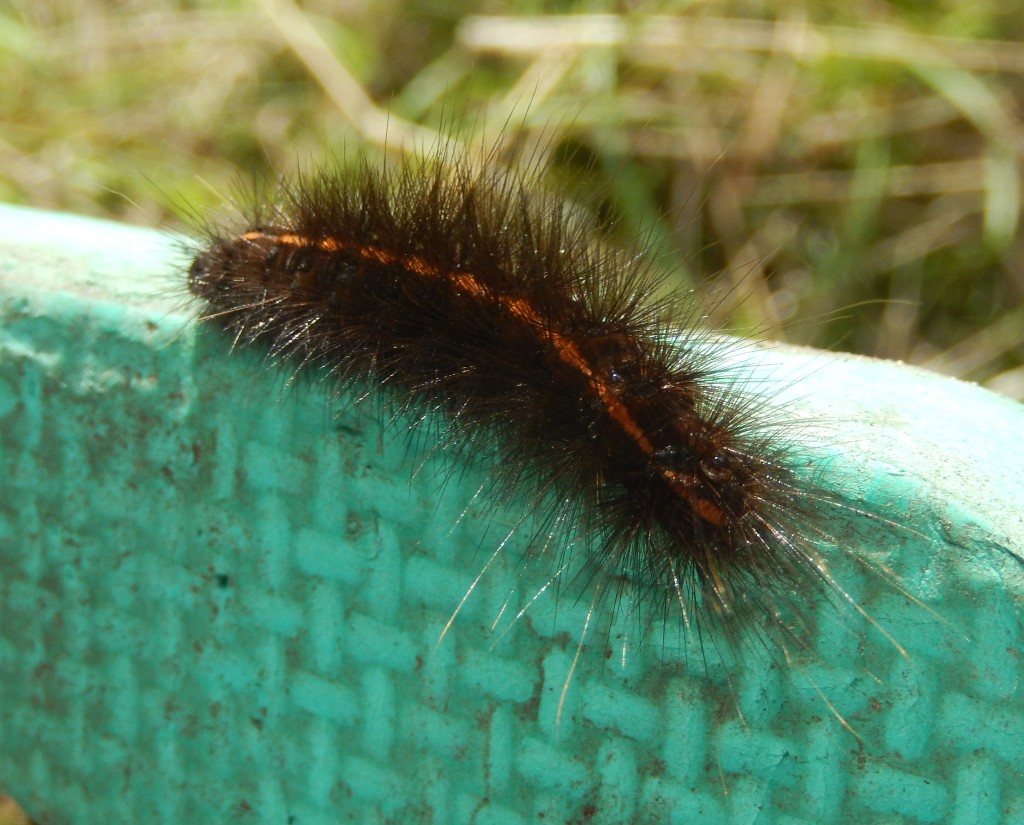
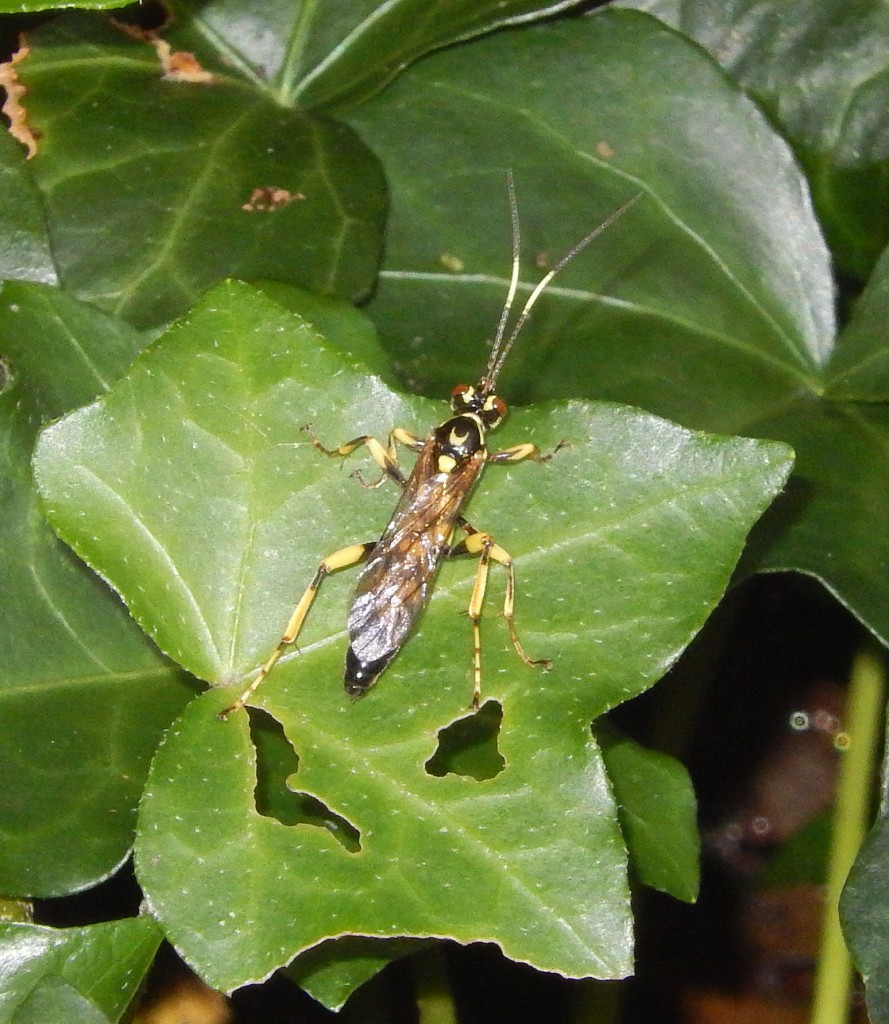
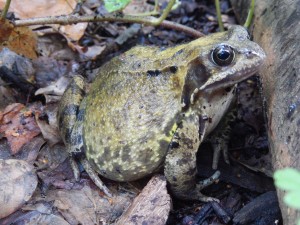
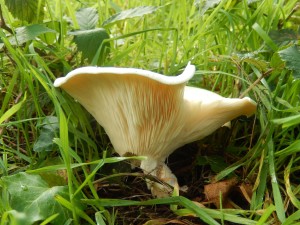
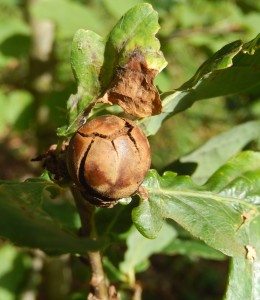
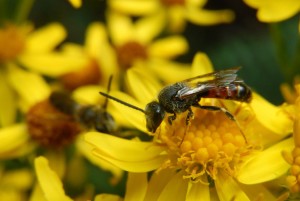
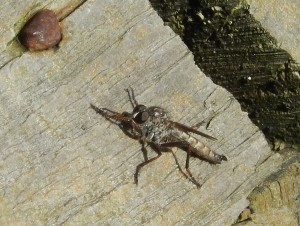

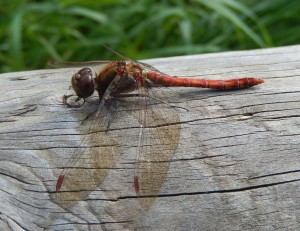
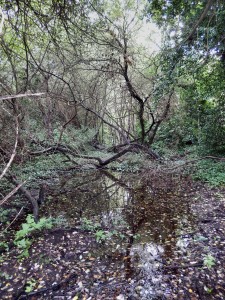
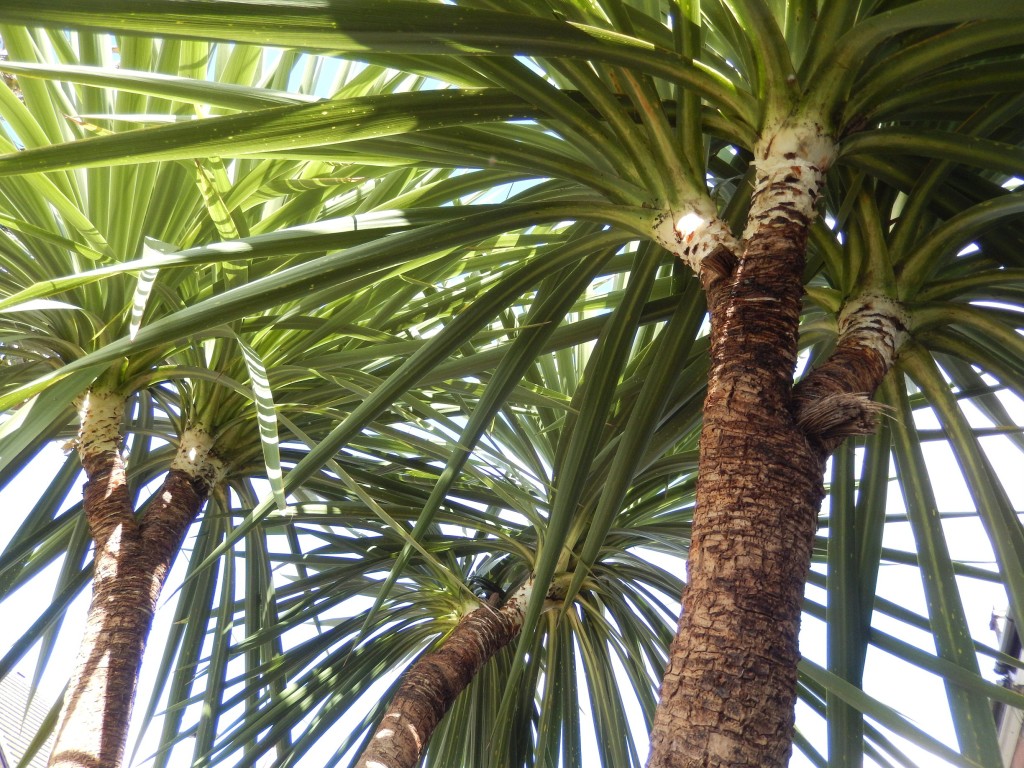
When I moved house, I dug up a small but strong Cordyline that I had planted in the garden, and brought it with me. It was a couple of feet high. I stuck it in the ground and more or less forgot about it: it didn’t seem to do much except grow a little bit taller each year. It had two cylindrical trunks, each of which acquired a few new leaves every year, forming a palm-like tuft. The old leaves remained as a multiple sheath around the trunk until they eventually fell off in a storm or I pulled them off, following the Fibonacci spirals from the bottom up.
About 10 years ago, one of the trunks decided to branch; then the plant settled down again, and the three trunks just crept slowly skywards each year.
Two or three years ago, the plant suddenly put out a flower head, covered in a mass of tiny whitish flowers. The head slowly dried up but did not fall; it was attached to an extremely strong fibrous stalk that emerged in what seemed to be a random way from the tuft of leaves. A year later, another flower head emerged. With difficulty I managed to cut the old flower head off near its base: being left to dry had hardened it, but nothing else.
Now, after this year’s growth and an hour carefully pulling off a lot of leaves from the bottom of each tuft, no fewer than 8 growing points – separate tufts – are visible. And the mystery of where the flower heads come from is revealed: they spring from the angle or axil where a trunk decides to fork into two branches. There’s a nice obvious cut stump of a flower head on the right of the photo.
As well as I can now deduce, the number of growing points went like this :
Year: Tips: Branching events: Flower heads:
1 1
3 2 1
8 3 1
17 4 1 1
18 6 2 2
19 8 2 0 so far
The production of leaves seems to be increasing directly with the number of growing points. The old trunks do seem slowly to thicken, despite giving the impression of growing only at the tip, i.e. there is some secondary (sideways) growth as well as primary growth at the apical meristem. Cordyline is, curiously, a woody monocot, in the Asparagus family.
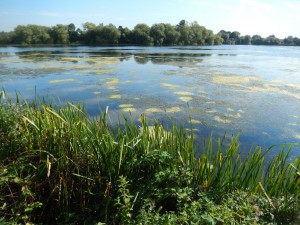
The usually clear lake was covered in thick green patches of weed, enough for Coots to be able to walk on.
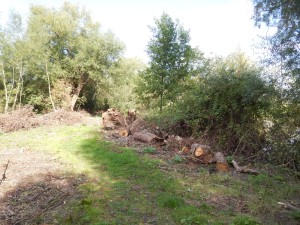
The path, too, looked rather different, with many of the large creaky poplars cut down leaving a wide unfamiliar swath of bulldozed path. The poplars constantly drop branches and fall over so it was about time.
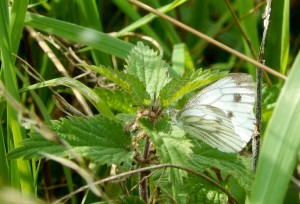
There were not many insects about – Emperor Dragonfly, Migrant Hawker, Common Blue Damselfly (with the ace-of-spades on segment 1 of the abdomen), Green-Veined White, a few Speckled Wood was about it.
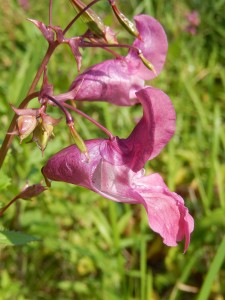
I don’t recall seeing much of that troublesome weed of nature reserves, the Himalayan Balsam, but it was evident in cleared areas. Shame it’s a nuisance, as it’s rather a beautiful plant.
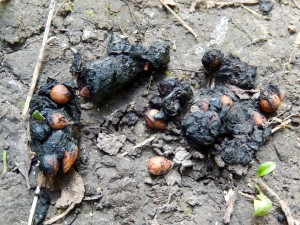
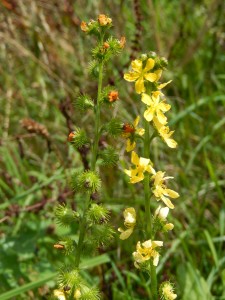
Warm September weather usually means no migrants as they all settle down to enjoy the last bit of summer before moving. I heard a Cetti’s Warbler and a brief unseasonal burst of Chiffchaff song; I think I glimpsed a Blackcap diving from a patch of Teasels back to its bush. A few Jays shrieked and flapped butterfly-like across the horse pasture. A lone Kestrel flew lazily to perch in a tree. On the water, not much apart from Coots, a Mute Swan, Mallard, a family of Egyptian Geese, some Cormorants (quite a few of them with a lot of white on their fronts).
An Apple tree glowed with nice ripe fruit; someone had beaten a path under it to do a little picking.